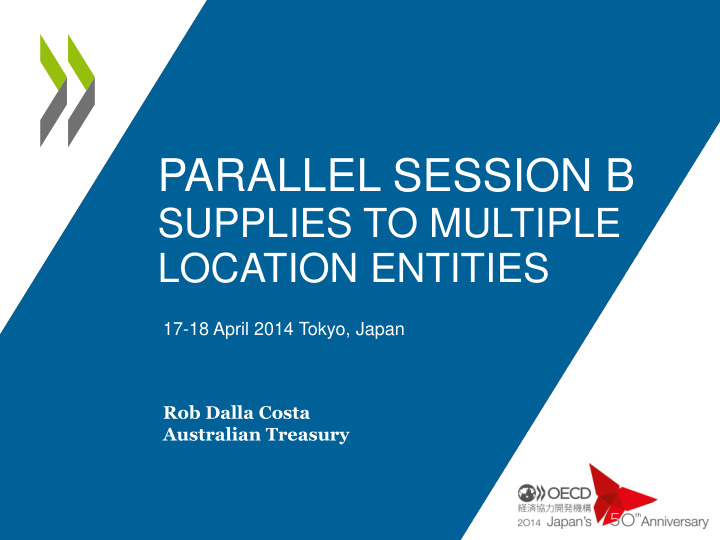



PARALLEL SESSION B SUPPLIES TO MULTIPLE LOCATION ENTITIES 17-18 April 2014 Tokyo, Japan Rob Dalla Costa Australian Treasury
Which approach is for you? • The Guidelines contained a range of approaches – Direct use, Direct delivery, and the Recharge approach • Having options provides greater flexibility for Govts. to ensure the integrity of VAT systems – Important consideration in developing countries where VAT administration and compliance is less robust • Importantly I do not see it as choice between options - rather the opportunity to mix ‘n match 2
Which approach? • The recharge approach is favoured by many as it’s seen as administratively easier for business – MLE’s would prefer a single approach worldwide but this may pose risk for Govts. • Issues/risks arising under the recharge are: – Timing - How long before there is an internal recharge? – Value - Will the recharge reflect its actual value? – Identification - who is the business agreement really with? – Collection – How will tax authorities know when the recharge occurs. Will it be correctly apportioned if used by the local branch to make input taxed (exempt) supplies? 3
A look at the risks • Can Govts. reduce these risks? Are there alternatives to giving up your taxing rights now in the hope that it will flow back via a recharge? • Where it is clear that the local supplier is making part of the supply to a local branch of the MLE why not treat this supply like any other and tax it now? • It may be appropriate to tax this supply using a combination of the recharge and direct delivery approaches without adding administrative/compliance costs for taxpayers or administrations 4
Analysis of case study provided Analysis of the case study • I will focus on that part of the supply that is from software supplier S in country A to branch A also in country A • The case study is about supplies of pre-designed software – where the supplier has no way of knowing how often and what value of software will be downloaded by the various branches then the recharge approach offers a practical solution • But consider if the supply is of software specifically designed for each branch to comply with its regulatory obligations in its jurisdiction? 5
Analysis of case study provided Analysis of the case study (continued) • Given the nature of the new supply by supplier S I question the merits of adopting a single recharge approach, particularly where a substantial part of the supply is directly delivered and consumed in the country where the supplier also resides • For example, why not adopt a ‘hybrid’ approach which combines the recharge with the direct delivery approach? – Unlike pre-designed software downloads the supplier S will have details of the software being developed for branch A and which they supply directly to the local branch in their country 6
Case study continued How would this hybrid approach work? Business agreement still central • – It will detail what jurisdictions and branches the services need to be supplied to – Supplier S will need to interact with experts (or software users) in branch A to deliver the service Amount to be charged by S to each branch, incl. branch A, is likely to be specified in the agreement – • Steps for using a ‘hybrid’ approach i. Supplier S carves out of the agreement that part of the supply delivered locally and taxes this as any other domestic supply ii. Zero rate the remaining part of the supply under the business agreement to the extent it relates to non-domestic supplies iii. MLE HQ will then recharge amounts to all but no reverse charge required for branch A. Branch A via its domestic registration can claim a GST/VAT credit to the extent of their eligibility • Advantages : – Reduced risk of revenue leakage for Govt., particularly for Govts. where tax administration/compliance is weak – Little additional compliance for supplier S where the business agreement identified what/how much is to be supplied to branch A locally • Govts. need to consider which approach, or combination of approaches, delivers the best outcomes having regard to principles in the Guidelines 7
Questions? Rob Dalla Costa (Australian Treasury) 8
Recommend
More recommend